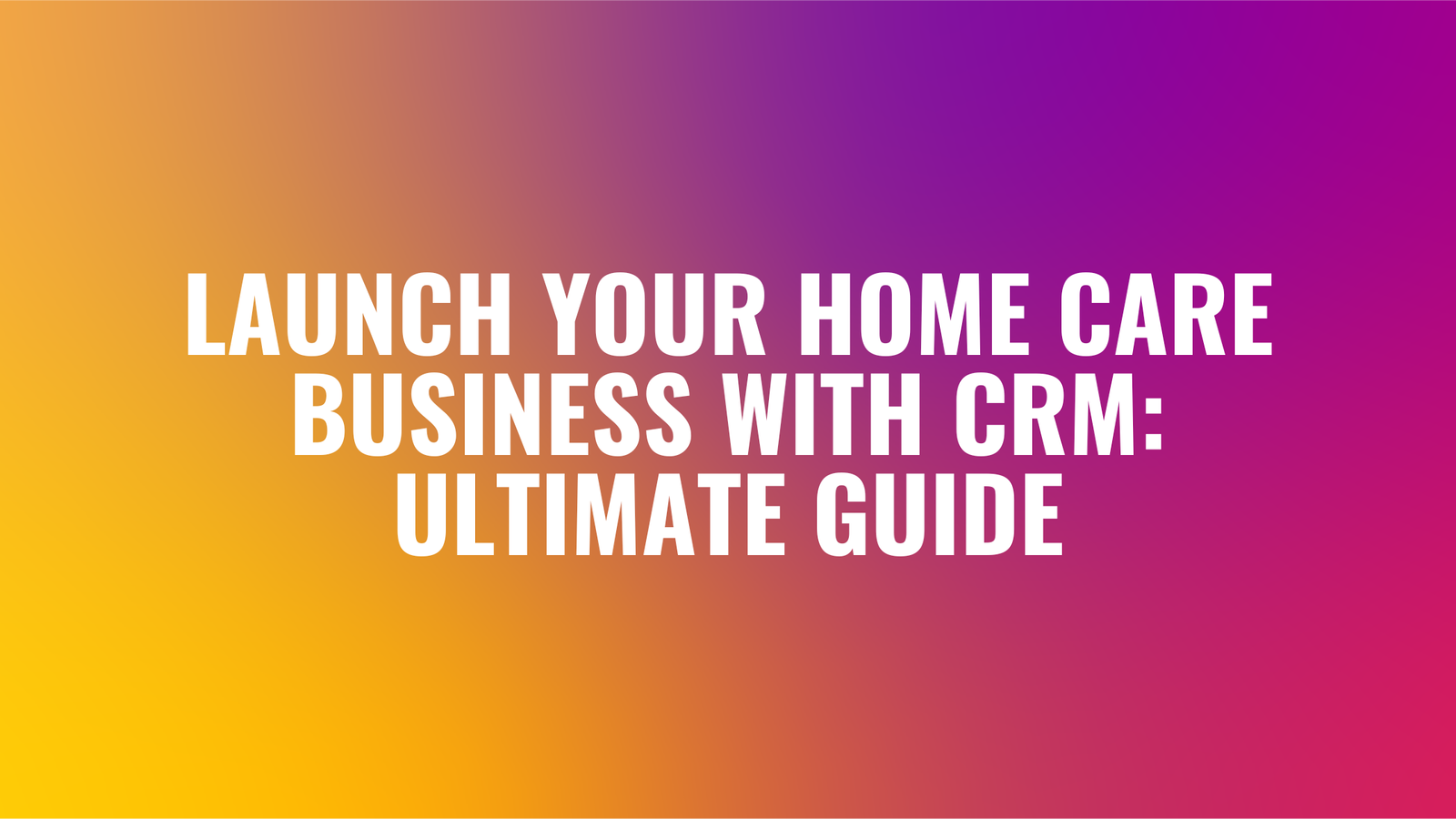
Starting a home care business can be both a rewarding and challenging venture. The demand for domiciliary care services is on the rise due to an aging population and the increasing preference for in-home care over institutional settings. However, managing a home care business involves coordinating caregivers, managing client relationships, ensuring regulatory compliance, and much more. Leveraging a Customer Relationship Management (CRM) system can streamline these processes and set the foundation for a successful business. This guide will walk you through the steps to Launch Your Home Care Business with CRM and how to integrate it to optimise your operations.
Step 1: Research and Planning
Market Research To Launch Your Home Care Business with CRM, begin by conducting thorough market research. Understand the demographics and needs of your target market, including the types of services most in demand, pricing structures, and key competitors in your area.
Business Plan Create a comprehensive business plan that outlines your business objectives, target market, services offered, pricing strategy, marketing plan, and financial projections. Your business plan should also detail how you will incorporate a CRM system to manage client relationships and streamline operations.
Regulatory Requirements Familiarise yourself with the regulatory requirements for starting a home care business in your area. This includes obtaining the necessary licenses and certifications, adhering to health and safety regulations, and ensuring compliance with data protection laws.
Step 2: Setting Up Your Business
Legal Structure Choose the legal structure for your business (e.g., sole proprietorship, partnership, LLC, or corporation). Each structure has different implications for liability, taxes, and regulatory compliance.
Financing Secure financing to cover your startup costs, which may include licensing fees, insurance, office space, equipment, and initial payroll. Options include personal savings, bank loans, or investors.
Insurance Obtain the necessary insurance policies, including liability insurance, professional indemnity insurance, and worker’s compensation insurance, to protect your business and employees.
Hiring Staff Recruit qualified caregivers and administrative staff. Ensure they have the necessary certifications and experience, and provide them with comprehensive training to uphold your service standards.
Step 3: Implementing a CRM System
Choosing the Right CRM Select a CRM system that caters to the specific needs of a home care business. Zoho CRM is a robust option that offers customisation, integration with other tools, and advanced features for managing client relationships and business operations.
Setting Up CRM Customise your CRM to fit your business model. This involves creating custom fields to capture essential client information, setting up modules for different aspects of your operations (e.g., lead management, client management, caregiver scheduling), and defining workflows to automate routine tasks.
Integrating CRM Integrate your CRM with other tools you use, such as email marketing platforms, accounting software, and scheduling tools. This ensures seamless data flow across your systems and reduces manual data entry.
Training Staff Train your staff on how to use the CRM effectively. Provide comprehensive training sessions and resources to ensure everyone understands how to input data, access client information, and utilise the CRM’s features to enhance their productivity.
Step 4: Attracting Clients
Marketing Strategy To Launch Your Home Care Business with CRM, develop a marketing strategy to attract clients. Use a combination of online and offline marketing tactics, including a professional website, social media presence, content marketing, local advertising, and partnerships with healthcare providers.
Website and SEO Create a professional website that clearly outlines your services, showcases testimonials, and provides a user-friendly experience. Optimise your website for search engines (SEO) to increase visibility and attract organic traffic.
Content Marketing Leverage content marketing to establish your expertise and build trust with potential clients. Publish blog posts, articles, and videos that provide valuable information on home care services, industry trends, and tips for caregivers.
Social Media Maintain an active presence on social media platforms where your target audience is likely to be. Share informative content, engage with your followers, and use social media advertising to reach a broader audience.
Lead Generation Use your CRM to capture and manage leads from various sources. Integrate lead capture forms on your website and social media profiles to collect contact information from interested prospects.
Step 5: Managing Operations
Client Onboarding Use your CRM to streamline the client onboarding process. Automate the initial contact, schedule consultations, and manage the documentation required to start services. Keep all client information in a centralised location for easy access.
Scheduling and Assignment Efficiently manage caregiver schedules and assignments using your CRM. Match caregivers with clients based on their needs, preferences, and availability. Use the CRM to track appointments, send reminders, and manage any changes in schedules.
Communication Maintain open lines of communication with clients and caregivers through your CRM. Use automated emails and SMS notifications to keep everyone informed about schedules, changes, and important updates.
Compliance and Documentation Ensure compliance with regulatory requirements by using your CRM to manage documentation. Keep detailed records of client interactions, care plans, incident reports, and caregiver certifications. Automate reminders for compliance-related tasks such as training renewals and safety checks.
Billing and Invoicing Streamline your billing and invoicing processes with your CRM. Generate invoices, track payments, and manage financial records efficiently. Integrate your CRM with accounting software to ensure accurate financial management.
Step 6: Monitoring and Improving
Performance Metrics Use your CRM’s analytics and reporting features to monitor key performance metrics such as client satisfaction, caregiver performance, and financial health. Generate regular reports to assess your business’s performance and identify areas for improvement.
Client Feedback Collect feedback from clients regularly to understand their satisfaction levels and identify any areas for improvement. Use this feedback to make necessary adjustments to your services and enhance the client experience.
Continuous Improvement Continuously refine your processes based on the insights gained from your CRM. Implement best practices, update training programs, and adopt new technologies to stay competitive and deliver high-quality care.
Conclusion
Starting a home care business involves many complex tasks, from regulatory compliance to client management. Implementing a CRM system like Zoho CRM can significantly streamline these processes, allowing you to focus on providing high-quality care to your clients. By following this guide, you can set up a successful home care business that leverages CRM technology to optimise operations, improve client relationships, and drive growth.
Ready to Launch Your Home Care Business with CRM?
Implementing a CRM system can transform your home care business, making operations smoother and more efficient. Whether you’re just starting or looking to streamline your existing processes, our expert team is here to help.
Contact us today to learn how Zoho CRM can revolutionise your home care services!
